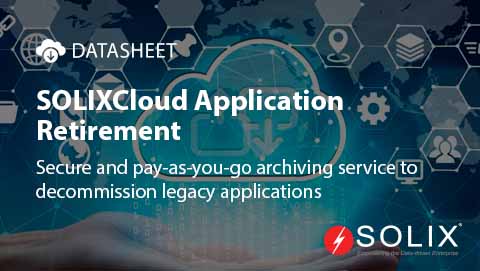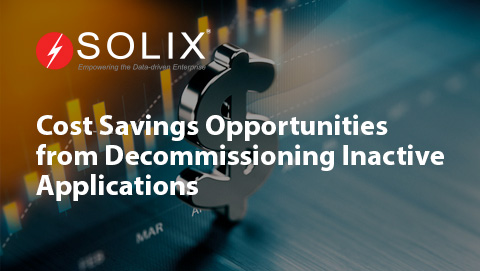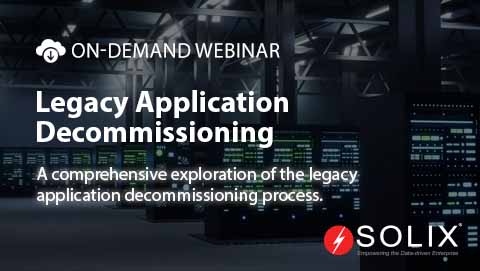Define Legacy System in Software Engineering
Todays tech fueled world of technology, legacy systems in software engineering have become a hindrance for many organizations. These outdated systems, often built on old platforms or using obsolete technology, can slow down operations, increase maintenance costs, and pose security risks. So, what exactly is a legacy system in software engineering?
Legacy systems in software engineering are outdated technologies or applications that are still in use within an organization. These systems may have been developed years ago and are no longer supported by the original vendor, making them difficult and costly to maintain. The challenge for many businesses is how to modernize or replace these legacy systems without disrupting daily operations.
Enter Solix Solutions, a game-changer in the world of application retirement and decommissioning. Solix offers an innovative approach to retiring legacy applications, helping organizations rationalize their application portfolio and reduce infrastructure costs. By transitioning away from complex, on-premises legacy application management to modern, SaaS-based alternatives, Solix enables companies to save time, money, and resources.
- Imagine for a second your in a scenario where a large corporation, let’s call it Acme Corporation, is burdened with a plethora of legacy applications that are draining valuable resources. With Solix’s cloud application retirement and decommissioning service, Acme Corporation can retire and decommission these outdated systems at a low, fixed monthly cost.
- Solix also provides structured, unstructured, and semi-structured data support, ensuring a seamless transition away from legacy applications.
- Beyond that, Solix’s application-specific accelerators for popular platforms like SAP, Oracle e-Business Suite, and PeopleSoft, as well as connectors for virtually any data management system, make the migration process smooth and efficient.
- End-users can still access legacy data through full-text search, reports, and ad-hoc query, ensuring business continuity and compliance.
- Solix’s enterprise archiving solution offers a fully managed, cloud-scale archive repository for less-active enterprise data, including structured, semi-structured, and unstructured data.
- This centralized data governance and administration platform helps organizations improve application performance, optimize infrastructure, and meet compliance objectives with ease.
Furthermore, Solix’s information lifecycle management (ILM) solutions provide organizations with the tools and frameworks needed to manage data effectively throughout its lifecycle. By classifying data at creation, moving data across infrastructure tiers, and establishing retention policies based on business rules, organizations can optimize their infrastructure, reduce costs, and ensure compliance.
So, why wait? Take a step towards modernizing your organization’s legacy systems with Solix Solutions. Whether you’re a small startup or a multinational corporation, Solix’s cost-saving approach to application retirement and decommissioning can help streamline your operations, enhance security, and drive innovation. Don’t let legacy systems hold you back. Embrace the future with Solix.
And don’t forget to sign up for a chance to win $100 by entering your email on the right. We can’t wait to help you define legacy system in software engineering and help grow your business!
I hope you enjoyed learning about define legacy system in software engineering. Always, if you have more questions about define legacy system in software engineering, use the form above to reach out to us.
My goal was to introduce you to ways of handling the questions around define legacy system in software engineering. As you know, it’s not an easy topic, but we help fortune 500 companies and small businesses alike save money when it comes to define legacy system in software engineering. So, please use the form above to reach out to us.
DISCLAIMER: THE CONTENT, VIEWS, AND OPINIONS EXPRESSED IN THIS BLOG ARE SOLELY THOSE OF THE AUTHOR(S) AND DO NOT REFLECT THE OFFICIAL POLICY OR POSITION OF SOLIX TECHNOLOGIES, INC., ITS AFFILIATES, OR PARTNERS. THIS BLOG IS OPERATED INDEPENDENTLY AND IS NOT REVIEWED OR ENDORSED BY SOLIX TECHNOLOGIES, INC. IN AN OFFICIAL CAPACITY. ALL THIRD-PARTY TRADEMARKS, LOGOS, AND COPYRIGHTED MATERIALS REFERENCED HEREIN ARE THE PROPERTY OF THEIR RESPECTIVE OWNERS. ANY USE IS STRICTLY FOR IDENTIFICATION, COMMENTARY, OR EDUCATIONAL PURPOSES UNDER THE DOCTRINE OF FAIR USE (U.S. COPYRIGHT ACT § 107 AND INTERNATIONAL EQUIVALENTS). NO SPONSORSHIP, ENDORSEMENT, OR AFFILIATION WITH SOLIX TECHNOLOGIES, INC. IS IMPLIED. CONTENT IS PROVIDED "AS-IS" WITHOUT WARRANTIES OF ACCURACY, COMPLETENESS, OR FITNESS FOR ANY PURPOSE. SOLIX TECHNOLOGIES, INC. DISCLAIMS ALL LIABILITY FOR ACTIONS TAKEN BASED ON THIS MATERIAL. READERS ASSUME FULL RESPONSIBILITY FOR THEIR USE OF THIS INFORMATION. SOLIX RESPECTS INTELLECTUAL PROPERTY RIGHTS. TO SUBMIT A DMCA TAKEDOWN REQUEST, EMAIL INFO@SOLIX.COM WITH: (1) IDENTIFICATION OF THE WORK, (2) THE INFRINGING MATERIAL’S URL, (3) YOUR CONTACT DETAILS, AND (4) A STATEMENT OF GOOD FAITH. VALID CLAIMS WILL RECEIVE PROMPT ATTENTION. BY ACCESSING THIS BLOG, YOU AGREE TO THIS DISCLAIMER AND OUR TERMS OF USE. THIS AGREEMENT IS GOVERNED BY THE LAWS OF CALIFORNIA.
-

-

-
 White Paper
White PaperCost Savings Opportunities from Decommissioning Inactive Applications
Download White Paper -

